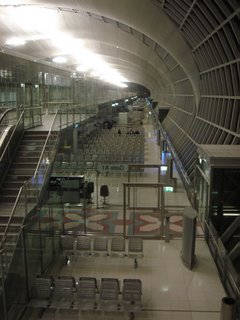Suvarnabhumi Int'l Airport: Thaksin's Last Megaproject
 Suvarnabhumi's boarding gates
Suvarnabhumi's boarding gatesBangkok, October 2, midnight
Bangkok's Don Muang International Airport finally closed its doors on the night of 27 September 2006, after 96 years in operation (and where it will then be transformed into a VIP/military airbase). Don Muang will forever stand as the symbol of Bangkok's transformation from a marginal Southeast Asian city into a regional and global hub, replacing Rangoon since 1962 as Southeast Asia's most important transportation hub when Burma faded away from the international scene.
Don Muang's coziness (or crampness some would say) and colourful history (which includes covert Indonesian-Malaysian peace negotiations in 1966, hordes of evacuation flights from Vietnam in 1975, the hijacking of an Indonesian plane in 1981, drug trafficking dramas, etc) has finally come to an end. Enter Suvarnabhumi (pronounced Suwan-na Phoom, 'Land of Gold') International airport.
Suvarnabhumi International Airport already made history by being marked as the swansong of Prime Minister Thaksin Shinawatra's endless series of megaprojects and alleged corruption scandals. The airport project, itself in the making for over 40 years and another lucrative profit tap for Thaksin's family coffers (see Bangkok Post, Sept. 13, 2006), had been bogged by several delays and false starts. (Thaksin initiated its soft opening late last year, though largely symbolic). Without much fanfare, Thailand's new military rulers kept the official 28 September opening on schedule, while Thaksin, himself ousted by a bloodless coup d'etat on 19 September, could only watch (if he does at all) from the sidelines at his London hotel sanctuary.
I flew through Suvarnabhumi on its fourth day being in full operation. First impression: it IS huge, but simultaneously, being dominated by colours of steel, very cold and menacing. Its grandeur alone was a local attraction, to a point where the government had to publicly discourage the public from sightseeing and jeopardizing the traffic to and from the airport. (Bangkok Post, 1 Oct, 2006)
Both Suvarnabhumi and KLIA may outdo Singapore's Changi in terms of grandeur, though I doubt Changi would soon drop out from the favourite airports list. Changi was designed with human psychology in mind: passengers just want to relax, feel cozy, or shop after long haul flights, without having to walk for miles to reach the immigration gate. Suvarnabhumi and KLIA are made to stun and intimidate visitors. Yes, they really have ways to make you WALK.
Many smoking rooms had yet to be opened, but following our excellent Southeast Asian traditions, everything could be 'fixed'. A willing airport janitor showed us places where we were (supposedly) allowed to smoke: in the fire exits !
Though the flight transfer was smooth, a serious problem occured during take off. Apparently one of the two major runways suffered from surface cracks, and hundreds of incoming and departing flights were being bottlenecked on the apron. It took 80 minutes for our flight to taxi away from the terminal to the main runway.
Smooth as silk...
 Cold demeaning steel
Cold demeaning steel Suvarnabhumi's displays of light
Suvarnabhumi's displays of light One of the few operational Smoking rooms
One of the few operational Smoking rooms Japanese Mild Sevens & Marlboros, Korean-made Esses & Salems
Japanese Mild Sevens & Marlboros, Korean-made Esses & Salems

2 Comments:
Dear Bang Dave
Bandara, saya berangkat dari sana kemarin.
Masalahnya adalah ketidaksiapan yang diakibatkan oleh korupsi..
Sittha
Foto asbaknya konseptual sekali sih Dave. Perlambangan situasi kekinian. Semangat nasionalisme dalam invasi westernisasi. Hehehe....
Post a Comment
<< Home